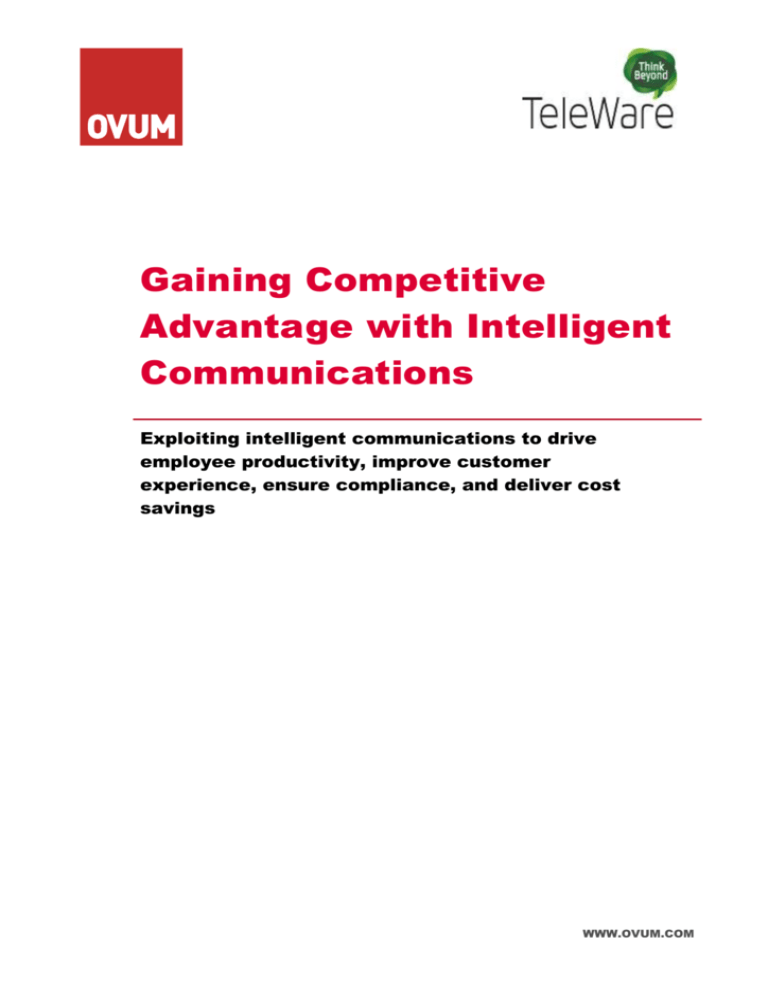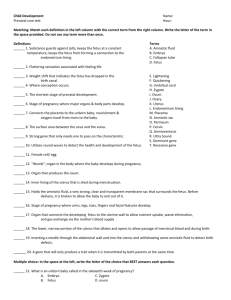
Gaining Competitive
Advantage with Intelligent
Communications
Exploiting intelligent communications to drive
employee productivity, improve customer
experience, ensure compliance, and deliver cost
savings
WWW.OVUM.COM
WWW.OVUM.COM
WHITE PAPER
Author: Saurabh Sharma
Published: November 2014 © Ovum
EXECUTIVE SUMMARY
CATALYST
Enterprise mobility and the need to improve customer experience are forcing businesses to look
for alternatives that enable a shift away from fragmented communications infrastructures and
towards a well-integrated communications and collaboration stack. This is of utmost importance for
customer-facing functions, as they can no longer hope to compete by providing “good enough”
customer experience and engagement capabilities. Moreover, persistent time and budget
constraints further reduce the number of options available for supporting this transformation.
OVUM VIEW
Communications account for about 22% of the enterprise IT spend and considering that about
80% of the IT budget is used for “keeping the lights on”, the goal of meeting critical business
requirements with limited scope for adoption of new ICT solutions/platforms seems difficult to
achieve. There are several areas where enterprises need to invest in order to ensure “relevance”
to more demanding and empowered customers. Enterprise mobility and digitalization are driving
major changes in the expectations of customers, as well as necessitating adoption of more agile
and flexible approaches to communications and collaboration.
For customer-facing functions, this translates into the need to provide a compelling customer
experience across a range of channels, including digital touch points. Business functions, such as
HR, sales, marketing, and customer service need to support the mobility requirements of
employees to drive better collaboration, engagement, and productivity within and outside the
enterprise.
Intelligent communications bridge the gaps between traditional telephony services, mobile
communications, and emerging collaboration applications to improve synergies between customer
service capabilities and customer expectations. Moreover, by enabling the development of more
flexible communications and collaboration capabilities, intelligent communications provide effective
support for enterprise mobility and help ensure that businesses are able to quickly adapt to
changes in customer requirements and maintain and strengthen their competitive positioning. With
the provisions for analyzing qualitative and quantitative aspects of both internal and external
communications, intelligent communications help drive “continuous improvement” in customer
service and engagement capabilities, as well as increasing return on investment (ROI) on
communications spend.
METHODOLOGY
The views expressed in this white paper are based on Ovum’s ongoing independent research into
this specific market, which takes into account the opinions of industry consortiums, enterprise
business and IT leaders, and relevant practitioners, as well as the market experiences of
TeleWare.
Gaining Competitive Advantage with Intelligent Communications
© Ovum.
Page 2
Published 11/2014
WWW.OVUM.COM
WHITE PAPER
CHANGING BUSINESS REQUIREMENTS AND THE ‘NEW’ WORKPLACE
IMPROVING CUSTOMER SATISFACTION AND MEETING SECURITY AND
COMPLIANCE MANDATES IS A KEY PRIORITY FOR ENTERPRISES
Ovum ICT Enterprise Insights survey results (Figure 1) revealed the key business challenges for
enterprises in the UK and unsurprisingly, improving customer satisfaction and compliance with
security mandates figure amongst the top three challenges. Gone are the days when organizations
were able to compete based on a “good enough” customer service and engagement strategy. In
the current operating environment, organizations need to understand individual customer
preferences and motivations, and subsequently take corrective action to remain relevant in an
increasingly competitive marketplace.
Communications and collaboration systems, in their various guises, are a foundational element of
customer experience management and it is time organizations thought about analyzing the context
of usage to better understand and influence customer behavior.
Figure 1: Main business challenges for enterprises in the UK
Source: Ovum ICT Enterprise Insights (N=368)
As per Ovum ICT Enterprise Insights survey results, managing risk, security, and compliance is
the leading IT trend for 2014–15. Moreover, the complex interplay of stringent regulatory mandates
and data security and privacy concerns associated with enterprise mobility and the “bring your own
device” (BYOD) trend are driving investments in security solutions.
In this context, mobile compliance mandates for financial services organizations represent a good
case in point. Mobile call recording solutions/services help with compliance to regulatory
mandates, as well as enabling organizations to derive insights from operational and customer data
to drive business improvements, be it for improving customer service or for channel management.
Gaining Competitive Advantage with Intelligent Communications
© Ovum.
Page 3
Published 11/2014
WWW.OVUM.COM
WHITE PAPER
THE MOBILITY REQUIREMENTS OF THE MODERN ENTERPRISE
Modernization of the workplace calls for new approaches to communications
and collaboration
Ovum’s mobility survey results indicate a strong growth in BYOD adoption over the last couple of
years and it can be argued that this trend will continue to grow with both business and IT functions
realizing the inherent ‘strategic’ value. Enterprise mobility and more specifically, the BYOD trend,
represents a good opportunity for enterprises to drive greater employee productivity and better
internal and external collaboration. However, this requires significant changes in communications
infrastructure and processes. In particular, there is a need to bridge the gap between traditional
telephony services, mobile communications, enterprise applications, and collaboration tools to
deliver seamless communications and collaboration.
Silos at functional, infrastructure, and network levels continue to be a major barrier to the
realization of a “connected enterprise”. The modern workplace needs better integration across
different mediums for communications and collaboration to keep employees engaged and drive
business agility, process efficiency, and customer satisfaction. The key attributes of intelligent
communications align well with these requirements.
Key trends in enterprise mobility
Figure 2 provides insights into the key attributes associated with the use of employee-owned
smartphones and interestingly, about 18% of survey respondents prefer their smartphones to that
provide by the employer. Moreover, 37% of survey respondents agreed that smartphones provide
access to a range of applications that help drive productivity, while 35% were of the opinion that
their smartphones keep them up to date with key issues at their workplace.
Figure 2: Why do employees use their own smartphones?
Source Ovum: Employee Mobility Survey 2014, N=3,671
Gaining Competitive Advantage with Intelligent Communications
© Ovum.
Page 4
Published 11/2014
WWW.OVUM.COM
WHITE PAPER
BYOD is not a trend confined to a few business functions, but rather enjoys a good foothold across
the enterprise. Results from a recent Ovum employee mobility survey (Figure 3) indicate that
BYOD adoption has increased by at least ten percentage points over the last couple of years
across a majority of enterprise functions.
Figure 3: BYOD adoption continues to rise across different enterprise functions
Source: Ovum, Employee Mobility Survey 2012 (N=4,038), 2013 (N=4,371) 2014 (N=5,187)
While it may seem that IT is the main stakeholder, both from the perspective of enabling and
governing BYOD programs, there is significant value that individual business functions can extract
by supporting BYOD initiatives. Sales, marketing, customer service, and other functions will benefit
from greater employee productivity/resource utilization, and this in turn, would translate into
business agility and greater responsiveness to customer requirements.
Line-of-business (LOB)/function leaders are now a key participant in the IT spending decisionmaking process and therefore, it is essential that both business and IT stakeholders collaborate to
support BYOD initiatives. Intelligent communications help with mobility integration and fill gaps in
the existing communications infrastructure to provide a more conducive environment for BYOD
adoption.
CHANGING CUSTOMER EXPECTATIONS: THE INCREASING NEED TO DELIVER
BETTER CUSTOMER EXPERIENCE TO MAINTAIN COMPETITIVE ADVANTAGE
Ovum ICT Enterprise Insights survey results (Figure 4) indicate that a significant share of UKbased respondent enterprises plan to invest in new customer engagement technologies and
platforms, including those supporting mobile customer service, customer analytics, outbound
notifications, Web chat, workforce optimization, and multi-channel call routing.
With smartphones emerging as a key medium for customer service communications, enterprises
need to provide appropriate tools (such as, click-to-call within an application, mobile co-browsing,
Gaining Competitive Advantage with Intelligent Communications
© Ovum.
Page 5
Published 11/2014
WWW.OVUM.COM
WHITE PAPER
and chat) to deliver a compelling and well-integrated customer experience via mobile devices.
Moreover, customer analytics along with reporting capabilities can be used for deriving actionable
insights that help answer critical questions about customer service operations.
Figure 4: Investment plans for customer engagement technologies, UK
Source: Ovum ICT Enterprise Insights (N=368)
Customer service functions continue to operate under significant cost constraints and pressure to
handle customer inquiries more efficiently, with fewer transfers and more first-call resolutions.
Consequently, there is a great need for approaches that help maximize positive business
outcomes across different means of customer interaction. Customer analytics, when used as part
of intelligent communications, enables relevant business functions to identify trends/instances that
could be exploited for realizing positive business outcomes, such as cross-sell or upsell, reduction
in order cancellations, and successful reference sales.
For enterprises, the next phase of customer engagement will revolve around differentiating from
competitors based on an in-depth analysis of the context of usage and success of different
communications mediums/tools. Enterprises that fail to understand changes in customer
expectations run the risk of losing their competitive positioning, as they become a less attractive
option for customers.
Gaining Competitive Advantage with Intelligent Communications
© Ovum.
Page 6
Published 11/2014
WWW.OVUM.COM
WHITE PAPER
THE STRATEGIC BENEFITS OF INTELLIGENT COMMUNICATIONS
Intelligent communications enable organizations to exploit integrated communications and
collaboration capabilities to drive employee productivity and improve customer experience, while
reducing costs and increasing business process efficiency and responsiveness to new
requirements (Figure 5). In the current business environment, organizations need to improve the
efficiency of business processes and provide better services to customers through both
established and emerging channels to ensure competitive advantage in the marketplace.
Consequently, IT is under pressure to combine existing resources and infrastructure with emerging
technologies to deliver the desired functionality in the most cost-effective and time-efficient
manner.
Figure 5: Key attributes of intelligent communications
Source: Ovum
Business process execution time is a function of three main variables: the overall latency of IT and
communications systems (can vary with workload); the latency associated with human
involvement; and the complexity of different sub-processes. Most of the business-critical
processes have some sort of human involvement, and for this reason, the time taken for the
process to move from present stage to the next stage can vary depending on the availability of
skilled/authorized resources and a suitable medium enabling efficient communication between
them. In the case of client-facing processes, human involvement can result in bottlenecks leading
to delays and possible business loss (for example, customer churn due to poor customer service
or delays in interaction).
Organizations’ sales and marketing efforts aim to generate customer enquiries/calls, which need to
be handled efficiently to realize positive business outcomes. On many occasions, this aspect of
customer interaction is not given due importance and, consequently, organizations fail to convert
customer interest into sales. This is equally important from the perspective of maintaining and
improving engagement with existing customers. Intelligent communications ensure that customer
calls are routed to the appropriate staff (including both mobile and office workers) and mitigate the
risk of customer dissatisfaction due to unanswered calls or delay in response.
Gaining Competitive Advantage with Intelligent Communications
© Ovum.
Page 7
Published 11/2014
WWW.OVUM.COM
WHITE PAPER
The key benefits of intelligent communications include:
improvement in employee productivity and engagement with streamlined processes;
seamless flow of communications to minimize potential latency due to human involvement;
increased responsiveness via centralized management of key functions;
greater accountability for and visibility into customer interactions;
support for a range of communications mediums for better customer engagement;
faster delivery of information for decision-making;
more effective collaboration between stakeholders, both within and outside the enterprise;
and
better ROI on investments in communications solutions/applications.
Ovum ICT Enterprise Insights survey data indicates that, at a global level, communications will
account for about 23% of the enterprise IT spend in 2015. The corresponding figure for enterprises
in the UK is expected to be around 22%. Figure 6 provides a comprehensive split of the IT budget
allocations for communications for enterprises in the UK. Interestingly, over 15% of the IT budget
for communications is allocated to internal communications, which also support the requirements
of a mobile and productive workforce.
It is clear that enterprises spend a significant share of the IT budget on client communications and,
with persistent budget constraints, there are limited, if any, opportunities for securing additional
funding to optimize customer service. Consequently, there is a great need for approaches that
integrate existing communications and collaboration systems, fill gaps in existing capabilities,
rationalize opex, and enable optimization of both internal and external communications.
Figure 6: IT budget allocation for communications, UK
Source: Ovum ICT Enterprise Insights
Gaining Competitive Advantage with Intelligent Communications
© Ovum.
Page 8
Published 11/2014
WWW.OVUM.COM
WHITE PAPER
KEY USE CASES FOR INTELLIGENT COMMUNICATIONS
Mobile integration with business communications
Enterprise mobility programs call for an approach that allows converged communications with
seamless switching of mobile and fixed line calls. A suitable platform for converged mobility, both
at device and network levels, will allow centralized call management and routing and ease
integration with unified communications (UC) applications, as well as enabling better control over
voice calls, text messages, and data usage. It will allow enterprises to reduce mobile call costs by
routing through the corporate network. Moreover, such converged communications platforms
improve employee productivity and increase responsiveness to customer requirements by offering
mobile access to core telephony services and UC applications.
Automated call handling
A suitable combination of intelligent call routing and interactive voice response (IVR) systems
helps ensure that organizations are able to effectively answer high volumes of customer calls and
maintain competitive advantage. Automated call handling enables the automation of call routing
mechanisms based on caller choices. One of the key benefits of automated call handling is that it
acts as a ‘filter’ for external calls and can ensure that only calls requiring personalized assistance
are routed to customer service professionals. Automated call handling improves resource
utilization by helping ensure that repetitive queries are answered in an efficient manner without
involvement of customer service professionals.
As part of the evaluation process, enterprises should check that the call handling solution provides
an “easy-to-use”, intuitive graphical user interface (GUI) for development of custom applications
via a “drag and drop” (or similar) approach offering a pre-built library of standard
components/functions. This will reduce the time and effort involved in the development of custom
menu structures, as well as minimizing the need for specialized development skills.
Personal numbering
Personal numbering refers to a provision wherein a single virtual number is linked to a specific
person and calls can be initiated and received using this number, irrespective of user’s location,
device, and network. Personal numbering ensures that business-critical calls are answered in an
efficient manner, even in the case of mobile workers, teleworkers, homeworkers, and employees
working across different offices or using ‘hot desking’ facilities.
A key benefit of personal numbering is that it increases the number of customer calls answered
first time, while ensuring that customers connect with the appropriate employees, without any
unreasonable delays. In this context, organizations should ensure that the personal numbering
solution supports a range of networks and platforms, including traditional time-division multiplexing
(TDM) networks, digital private branch exchange (PBX), and internet protocol (IP) platforms. A
suitable solution will allow users to configure their current location via an “easy-to-use” browser
interface and voice prompts, and subsequently all incoming calls will be directed to the chosen
device.
Gaining Competitive Advantage with Intelligent Communications
© Ovum.
Page 9
Published 11/2014
WWW.OVUM.COM
WHITE PAPER
Private mobile networks
Private mobile networks (PMNs) provide access to fixed line communications via mobile devices,
which could be managed as part of corporate communications infrastructure. PMNs are well suited
for communications in areas having weak macro GSM (global system for mobile communications)
coverage, be it remote locations or areas with high disruption. In particular, PMNs allow mobile
devices to be used as PBX extensions and help ensure better coverage and connectivity across
the enterprise.
This provision allows better control over and visibility into mobile spend and usage, as well as
offering opportunities to reduce mobile spend depending on the responsibilities and usage
attributes associated with different employee profiles or corporate functions. From a broader
perspective, PMNs help ensure better connectivity and reachability to support time-efficient client
interactions, as well as supporting better collaboration within the enterprise.
Reporting capabilities for business intelligence
Call reports provide insights into call handling and call answering patterns, and can be used to
monitor and optimize customer interactions. In the context of intelligent communications,
operational data can be used for tracking the progress of key business initiatives (e.g., advertising
campaigns). For example, custom reports can be used to measure ROI on advertising spend.
Likewise, call reports help identify bottlenecks in the flow of communications (for example, call
routing mechanisms) to improve customer satisfaction. There are several cases where
organizations have significantly improved call answer rates and customer satisfaction with
operational data analytics.
CASE STUDIES
A major car manufacturer
The company needed a solution that would allow it to reduce the number of internal branch
receptionists by shifting to a centralized contact center as part of a cost reduction exercise. It used
the inbound call management capabilities offered by IVR systems managed from a central location
to direct calls to a contact center based in Manchester.
This provision allowed for a significant reduction in the number of branch-based receptionists,
which in turn, helped with the funding for the Manchester contact center. The comprehensive
reporting capabilities offered by the solution provided insights into call success rates, thereby
helping quantify customer experience.
A major independent tea trading and beverage packaging company
The company was using a digital enhanced cordless telecommunications (DECT) system for
wireless communications across different areas of its packaging site. As compatible handsets
were no longer available for the old DECT system, which itself was no longer supported, there was
a clear need for a suitable alternative. Moreover, the company faced issues with signal coverage
at the peripheral areas of the site, especially around the fire assembly points.
After following the process of quotation, evaluation, and negotiation, the company opted for a PMN
solution. The solution was integrated with the existing Cisco Call Manager supporting desktop
Gaining Competitive Advantage with Intelligent Communications
© Ovum.
Page 10
Published 11/2014
WWW.OVUM.COM
WHITE PAPER
extensions and connectivity with the public switched telephone system (PSTN). As the PMN
solution supported all standard 2G/2.5G handsets and required only a SIM change, the cost of
replacement was considerably less than with the old DECT system. Moreover, user migration and
onboarding exercise was completed in a time-efficient manner. The PMN solution ensured
excellent signal coverage across different parts of the site and with superior audio quality.
A professional services company
Given the nature of its work, the company had a large numbers of employees undertaking
international travel to deliver consulting services. The company used a personal numbering
solution to allow employees to log on from anywhere, and receive calls and retrieve voicemail at
their current location. The solution also provided a web-based GUI to enable screen dialing, which
ensured that calls were routed via a landline system based in the UK. This provision resulted in
significant savings from the perspective of international dialing costs and delivered ROI within a
year.
REALIZING THE TRUE BUSINESS VALUE OF INTELLIGENT
COMMUNICATIONS
DEVELOPING A STRATEGY TO EXPLOIT INTELLIGENT COMMUNICATIONS FOR
COMPETITIVE ADVANTAGE
The real value of intelligent communications lies in its ability to bridge the gaps between traditional
telephony services, mobile communications, and emerging collaboration applications and support
business growth with provisions for analyzing qualitative and quantitative aspects of both internal
and external communications. Therefore, it is important that key business and IT stakeholders
collaborate and develop a strategy to exploit intelligent communications for driving business
improvements.
The value proposition of integrated communications and collaboration systems is especially
attractive for enterprises that need to support mobility requirements of employees, while improving
the outcomes of customer communications. This is particularly important in the case of customerfacing functions, such as sales, marketing, and customer service teams, the performance of which
will have a direct impact on key business metrics, such as growth in customer base and customer
retention.
Enterprises should focus on making more effective and efficient use of existing communications
infrastructure and applications, especially as about 80% of the IT budget is used for “keeping the
lights on”. Intelligent communications offer a simple and cost-effective approach for improving the
customer experience aspect of external communications. For example, enterprises can achieve
mobile cost savings, better network coverage and connectivity, greater employee productivity, and
better response times with a suitable combination of a PMN and personal numbering solution.
Moreover, adoption of intelligent communications can progress along with a shift from traditional
communications systems towards unified communications and collaboration (UCC) solutions.
Depending upon their specific requirements, enterprises should identify areas where intelligent
communications can drive positive results. The results of this exercise should be used to define
Gaining Competitive Advantage with Intelligent Communications
© Ovum.
Page 11
Published 11/2014
WWW.OVUM.COM
WHITE PAPER
key objectives behind a move towards intelligent communications. Enterprises can involve an
appropriate vendor for mapping their requirements to the features and capabilities offered by
different intelligent communications solutions/platforms.
SELECTING THE RIGHT SOLUTION AND VENDOR
The evaluation process should focus on a comprehensive assessment of the features and
capabilities of intelligent communications solutions, with due consideration given to time and
budget constraints. It is also important that enterprises refrain from limiting their choices to vendors
with which they have an existing relationship. Enterprises should also understand that solutions
supporting limited interoperability at device/platform and network levels would fail to deliver longterm business value.
In additions to costs, enterprises should also consider the following points for evaluating different
solutions/vendors:
ease of integration with existing communications infrastructure;
support for a range of devices, applications, and network types;
understanding of local regulations and network conditions;
customer support and professional services capabilities;
demonstrated experience, including case studies and ROI analysis from previous
deployments;
ability to deliver customized solutions; and
data analytics and reporting capabilities.
USING DATA ANALYTICS TO DRIVE BUSINESS IMPROVEMENTS
Customer experience management is a key imperative for enterprises with digitalization and
mobility driving changes in employee and customer expectations. From the perspective of IT
spend, both LOBs and the core IT organization need to “do more with less”. As a result,
enterprises need to allocate budget and resources to areas integral to an adaptive customer
service and engagement strategy. Continuous improvement based on insights into operational and
customer data is essential for maintaining and strengthening competitive positioning, and even
more so as persistent time and budget constraints hinder a major transformation in
communications infrastructure.
Figure 7 shows the results of an Ovum survey aimed at understanding the key drivers for adoption
of customer interaction analytics. More than a third of survey respondents (36%) revealed that
their organizations are using customer interaction analytics to identify customer issues. An
interesting finding from the survey was that customer interaction analytics is being used for
tracking several key facets of customer experience management, including customer satisfaction,
first-contact resolution, and customer churn rate.
Gaining Competitive Advantage with Intelligent Communications
© Ovum.
Page 12
Published 11/2014
WWW.OVUM.COM
WHITE PAPER
Figure 7: Main reasons for using customer interaction analytics
Source: Ovum
Operational and customer interaction data analytics capabilities offered by intelligent
communications enable different functions within the enterprise to measure the ROI on
communications spend. For example, a customer service function can use comprehensive call
reports to track key metrics and identify gaps to improve the outcomes of subsequent customer
interactions.
Such reports can be used in combination with large streams of data on usage of different
components of enterprises’ communications infrastructure to gain actionable insights. For
example, enterprises can identify underutilized communications systems and resources and
accordingly take a decision to redeploy these to ensure a uniform distribution of communications
workload. Likewise, marketing functions can assess the success of individual campaigns based on
call traffic distribution across different demographic sets. This data can be used for extracting
granular insights to maximize ROI on marketing spend. Moreover, data analytics will enable
business leaders to make faster decisions based on insights gathered from different data sources
and mitigate the risk of missing out on new business opportunities.
CONCLUSION
RECOMMENDATIONS FOR ENTERPRISES
Intelligent communications allow enterprises to extract more value out of their investments in
communications infrastructure and collaboration platforms. With customers becoming more
demanding and empowered, and customer communications proliferating via different channels,
there is a great need to shift from communications ‘silos’ towards integrated communications and
collaboration capabilities. Moreover, mobility is having a significant impact on the way enterprises
serve and engage with their customers. Mobile integration with business communications and
Gaining Competitive Advantage with Intelligent Communications
© Ovum.
Page 13
Published 11/2014
WWW.OVUM.COM
WHITE PAPER
collaboration tools can significantly improve employee productivity and customer experience,
thereby driving and supporting business growth.
It is time enterprises thought about using intelligent communications to maintain and strengthen
their competitive positioning and realize strategic benefits that would otherwise require significantly
greater investment and/or large-scale communications infrastructure transformation.
APPENDIX
FURTHER READING
Achieving the True Business Value of Communications-Enabled Business Processes, IT016001475 (January 2013)
DEFINITIONS
Customer interaction analytics
This includes any tool that explores the behavior or motivation of the customer. For example, text
analytics looks at the specific performance of individual contact mechanisms or channels. It is
frequently used as an adjunct to speech analytics and performance management software, and
can deliver insights into customer chats and emails, and written transcriptions of verbal
conversations.
Web analytics explores the success or failure of particular pathways through a company’s
websites, with attention to identifying areas of disconnect that have an impact on either revenue or
customer longevity. Also included in this category are customer feedback and survey
management, journey mapping, and speech analytics.
Call recording
A call recording system allows conversations to be recorded as a voice file while a call is in
progress. The calls are then stored ready for playback through analytics or quality monitoring
systems. Modern call recording solutions also include encryption to hide sensitive data in the call.
Instant messaging (IM)
IM is a form of realtime, direct text-based communication between two or more people using PCs
or other devices, along with shared clients. The user's text is conveyed over a network such as the
Internet. More advanced IM software clients also allow enhanced modes of communication, such
as live voice or video calling.
Short message service (SMS)
SMS, also referred to as texting, sending text messages, or text messaging, is a service that
allows for short text messages to be sent from one mobile phone to another mobile phone or from
the Web to another mobile phone.
Gaining Competitive Advantage with Intelligent Communications
© Ovum.
Page 14
Published 11/2014
WWW.OVUM.COM
WHITE PAPER
SIM card
A subscriber identity module or subscriber identification module (SIM) is an integrated circuit that
securely stores the service-subscriber key (IMSI) used to identify a subscriber on a mobile
telephony device such as a mobile phone or computer.
AUTHOR
Saurabh Sharma, Senior Analyst, Ovum
saurabh.sharma@ovum.com
OVUM CONSULTING
We hope that this analysis will help you make informed and imaginative business decisions. If you
have further requirements, Ovum’s consulting team may be able to help you. For more information
about Ovum’s consulting capabilities, please contact us directly at consulting@ovum.com.
DISCLAIMER
All Rights Reserved.
No part of this publication may be reproduced, stored in a retrieval system, or transmitted in any
form by any means, electronic, mechanical, photocopying, recording, or otherwise, without the
prior permission of the publisher, Ovum (an Informa business).
The facts of this report are believed to be correct at the time of publication but cannot be
guaranteed. Please note that the findings, conclusions, and recommendations that Ovum delivers
will be based on information gathered in good faith from both primary and secondary sources,
whose accuracy we are not always in a position to guarantee. As such Ovum can accept no
liability whatever for actions taken based on any information that may subsequently prove to be
incorrect.
Ovum's Knowledge Centers are new premium services offering the entire suite of Ovum information in fully interactive formats.
To find out more about Knowledge Centers and our research, contact us:
Ovum Europe
Mortimer House
37-41 Mortimer Street
London W1T 3JH, UK
+44 20 7551 9000
crmgroup@ovum.com
Ovum Australia
Level 5, 459 Little Collins Street
Melbourne, VIC 3000
Australia
+61 3 9601 6700
Ovum New York
17 State Street, 32nd Floor
New York
NY 10004, USA
+1 212 686 7400
All Rights Reserved
No part of this publication may be reproduced, stored in a retrieval system or transmitted in any form by any means, electronic, mechanical, photocopying, recording or
otherwise, without the prior permission of the publisher, Ovum Europe Limited. Whilst every care is taken to ensure the accuracy of the information contained in this
material, the facts, estimates and opinions stated are based on information and sources which, while we believe them to be reliable, are not guaranteed. In particular, it
should not be relied upon as the sole source of reference in relation to the subject matter. No liability can be accepted by Ovum Europe Limited, its directors or
employees for any loss occasioned to any person or entity acting or failing to act as a result of anything contained in or omitted from the content of this material, or our
conclusions as stated. The findings are Ovum's current opinions; they are subject to change without notice. Ovum has no obligation to update or amend the research or
to let anyone know if our opinions change materially.
© Ovum. Unauthorised reproduction prohibited
This report is a licensed product and is not to be reproduced without prior permission.
Gaining Competitive Advantage with Intelligent Communications
© Ovum.
Page 15
Published 11/2014







